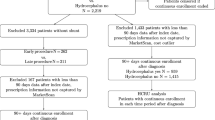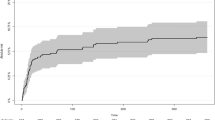Abstract
Aneurysmal subarachnoid hemorrhage (aSAH) is a devastating neurological condition. Endovascular coiling or surgical clipping have equivocal success rates, but relatively little is known regarding the health economics and complications of these procedures at the population level. We aimed to analyze the complication profiles and healthcare resource utilization (HRCU) associated with the treatment of aSAH in the USA. We performed a retrospective analysis utilizing the IBM MarketScan database between 2008 and 2015. Primary outcomes included economic analysis stratified by post-operative complication; determination of the effect of several factors on total cost by multivariable regression; and analysis of the incidence, timing, and associated HCRU of aSAH-related post-operative complications. Of the 2374 patients meeting inclusion criteria for economic analysis, 1783 (75.1%) patients had at least one of the ten complications. The most common complications included hydrocephalus (43.8%), transient cerebral ischemia (including vasospasm) (30.6%), ischemic stroke (29.1%), syndrome of inappropriate antidiuretic hormone (SIADH)/hyposmolarity/hyponatremia (22.1%), and seizures (14.9%). Patients who experienced complications had higher median 90-day total costs [$161,127 (Q1 to Q3, $101,411 to $257,662)] than those who did not [$97,376 (Q1 to Q3, $55,692 to $147,447)]. Length of stay was longest for those with pulmonary embolism and pneumonia (27 days) and shortest for those with SIADH/hyposmolarity/hyponatremia (16 days). Brain compression/herniation had the highest mortality rate (19.5%). In total, 14.6% of all patients experienced a readmission within 30 days. In conclusion, patients with aSAH have high post-operative complication rates and costs. Development of novel interventions to reduce complications and improve outcomes is crucial.

Similar content being viewed by others
Data Availability
The datasets generated during and/or analyzed during the current study are not publicly available due to the sensitive nature of the data. Specifically, this was queried from the IBM MarketScan database which is privately held and requires a paid subscription to access. Additionally, the queried data is exported and analyzed in an encrypted virtual workstation held at the institution performing the research. The data and analysis can be made available from the corresponding author on reasonable request.
References
International Study Of Unruptured Intracranial Aneurysms I. Unruptured intracranial aneurysms–risk of rupture and risks of surgical intervention. N Engl J Med. 1998;339:1725–33.
Kassell Nf, Torner Jc, Jane Ja, Haley Ec Jr, Adams Hp. The international cooperative study on the timing of aneurysm surgery. Part 2: surgical results. J Neurosurg. 1990;73:37–47.
Halkes Ph, Wermer Mj, Rinkel Gj, Buskens E. Direct costs of surgical clipping and endovascular coiling of unruptured intracranial aneurysms. Cerebrovasc Dis. 2006;22:40–5.
Hop Jw, Rinkel Gj, Algra A, Van Gijn J. Case-fatality rates and functional outcome after subarachnoid hemorrhage a systematic review. Stroke. 1997;28:660–4.
Van Der Schaaf I, Algra A, Wermer M, Molyneux A, Clarke M, Van Gijn J, et al. Endovascular coiling versus neurosurgical clipping for patients with aneurysmal subarachnoid haemorrhage. Cochrane Database Syst Rev. 2005:Cd003085.
Molyneux A, Kerr R, International Subarachnoid Aneurysm Trial Collaborative G, Stratton I, Sandercock P, Clarke M, et al. International Subarachnoid Aneurysm Trial (Isat) of neurosurgical clipping versus endovascular coiling in 2143 patients with ruptured intracranial aneurysms: a randomized trial. J Stroke Cerebrovasc Dis. 2002;11:304–14.
Ahn Jy, Han Ib, Yoon Ph, Kim Sh, Kim Nk, Kim S, et al. Clipping vs coiling of posterior communicating artery aneurysms with third nerve palsy. Neurology. 2006;66:121–3.
Bairstow P, Dodgson A, Linto J, Khangure M. Comparison of cost and outcome of endovascular and neurosurgical procedures in the treatment of ruptured intracranial aneurysms. Australas Radiol. 2002;46:249–51.
Barker Fg 2nd, Amin-Hanjani S, Butler We, Hoh Bl, Rabinov Jd, Pryor Jc, et al. Age-dependent differences in short-term outcome after surgical or endovascular treatment of unruptured intracranial aneurysms in the United States, 1996–2000. Neurosurgery. 2004;54:18–28 (Discussion -30).
Bellebaum C, Schafers L, Schoch B, Wanke I, Stolke D, Forsting M, et al. Clipping versus coiling: neuropsychological follow up after aneurysmal subarachnoid haemorrhage (Sah). J Clin Exp Neuropsychol. 2004;26:1081–92.
Brilstra Eh, Rinkel Gj, Van Der Graaf Y, Sluzewski M, Groen Rj, Lo Rt, et al. Quality of life after treatment of unruptured intracranial aneurysms by neurosurgical clipping or by embolisation with coils. A prospective, observational study. Cerebrovasc Dis. 2004;17:44–52.
Campi A, Ramzi N, Molyneux Aj, Summers Pe, Kerr Rs, Sneade M, et al. Retreatment of ruptured cerebral aneurysms in patients randomized by coiling or clipping in the International Subarachnoid Aneurysm Trial (Isat). Stroke. 2007;38:1538–44.
Chan A, Ho S, Poon Ws. Neuropsychological sequelae of patients treated with microsurgical clipping or endovascular embolization for anterior communicating artery aneurysm. Eur Neurol. 2002;47:37–44.
Chen Pr, Amin-Hanjani S, Albuquerque Fc, Mcdougall C, Zabramski Jm, Spetzler Rf. Outcome of oculomotor nerve palsy from posterior communicating artery aneurysms: comparison of clipping and coiling. Neurosurgery. 2006;58:1040–6 (Discussion -6).
Cowan Ja Jr, Ziewacz J, Dimick Jb, Upchurch Gr Jr, Thompson Bg. Use of endovascular coil embolization and surgical clip occlusion for cerebral artery aneurysms. J Neurosurg. 2007;107:530–5.
De Oliveira Jg, Beck J, Setzer M, Gerlach R, Vatter H, Seifert V, et al. Risk of shunt-dependent hydrocephalus after occlusion of ruptured intracranial aneurysms by surgical clipping or endovascular coiling: a single-institution series and meta-analysis. Neurosurgery. 2007;61:924–33 (Discussion 33-4).
Fontanella M, Perozzo P, Ursone R, Garbossa D, Bergui M. Neuropsychological assessment after microsurgical clipping or endovascular treatment for anterior communicating artery aneurysm. Acta Neurochir (Wien). 2003;145:867–72 (Discussion 72).
Frazer D, Ahuja A, Watkins L, Cipolotti L. Coiling versus clipping for the treatment of aneurysmal subarachnoid hemorrhage: a longitudinal investigation into cognitive outcome. Neurosurgery. 2007;60:434–41 (Discussion 41-2).
Gonda Dd, Khalessi Aa, Mccutcheon Ba, Marcus Lp, Noorbakhsh A, Chen Cc, et al. Long-term follow-up of unruptured intracranial aneurysms repaired in California. J Neurosurg. 2014;120:1349–57.
Groden C, Regelsberger J, Neumaier-Probst E, Grzyska U, Herrmann Hd, Zeumer H. Operative or endovascular treatment of ruptured intracranial vertebral artery aneurysms? Neuroradiology. 2000;42:685–91.
Helland Ca, Krakenes J, Moen G, Wester K. A population-based study of neurosurgical and endovascular treatment of ruptured, intracranial aneurysms in a small neurosurgical unit. Neurosurgery. 2006;59:1168–75 (Discussion 75-6).
Hoh Bl, Chi Yy, Dermott Ma, Lipori Pj, Lewis Sb. The effect of coiling versus clipping of ruptured and unruptured cerebral aneurysms on length of stay, hospital cost, hospital reimbursement, and surgeon reimbursement at the University of Florida. Neurosurgery. 2009;64:614–9 (Discussion 9-21).
Hoh Bl, Chi Yy, Lawson Mf, Mocco J, Barker Fg 2nd. Length of stay and total hospital charges of clipping versus coiling for ruptured and unruptured adult cerebral aneurysms in the Nationwide Inpatient Sample database 2002 to 2006. Stroke. 2010;41:337–42.
Investigators C. Rates of delayed rebleeding from intracranial aneurysms are low after surgical and endovascular treatment. Stroke. 2006;37:1437–42.
Javadpour M, Jain H, Wallace Mc, Willinsky Ra, Ter Brugge Kg, Tymianski M. Analysis of cost related to clinical and angiographic outcomes of aneurysm patients enrolled in the International Subarachnoid Aneurysm Trial in a North American setting. Neurosurgery. 2005;56:886–94 (Discussion -94).
Koivisto T, Vanninen R, Hurskainen H, Saari T, Hernesniemi J, Vapalahti M. Outcomes of early endovascular versus surgical treatment of ruptured cerebral aneurysms. A Prospective Randomized Study. Stroke. 2000;31:2369–77.
Lad Sp, Babu R, Rhee Ms, Franklin Rl, Ugiliweneza B, Hodes J, et al. Long-term economic impact of coiling vs clipping for unruptured intracranial aneurysms. Neurosurgery. 2013;72:1000–11 (Discussion 11-3).
Lusseveld E, Brilstra Eh, Nijssen Pc, Van Rooij Wj, Sluzewski M, Tulleken Ca, et al. Endovascular coiling versus neurosurgical clipping in patients with a ruptured basilar tip aneurysm. J Neurol Neurosurg Psychiatry. 2002;73:591–3.
Maud A, Lakshminarayan K, Suri Mf, Vazquez G, Lanzino G, Qureshi Ai. Cost-effectiveness analysis of endovascular versus neurosurgical treatment for ruptured intracranial aneurysms in the United States. J Neurosurg. 2009;110:880–6.
Molyneux Aj, Birks J, Clarke A, Sneade M, Kerr Rs. The durability of endovascular coiling versus neurosurgical clipping of ruptured cerebral aneurysms: 18 year follow-up of the Uk cohort of the International Subarachnoid Aneurysm Trial (Isat). Lancet. 2015;385:691–7.
Molyneux Aj, Kerr Rs, Yu Lm, Clarke M, Sneade M, Yarnold Ja, et al. International Subarachnoid Aneurysm Trial (Isat) of neurosurgical clipping versus endovascular coiling in 2143 patients with ruptured intracranial aneurysms: a randomised comparison of effects on survival, dependency, seizures, rebleeding, subgroups, and aneurysm occlusion. Lancet. 2005;366:809–17.
Nagashima H, Kobayashi S, Tanaka Y, Hongo K. Endovascular therapy versus surgical clipping for basilar artery bifurcation aneurysm: retrospective analysis of 117 cases. J Clin Neurosci. 2004;11:475–9.
Qureshi Ai, Janardhan V, Hanel Ra, Lanzino G. Comparison of endovascular and surgical treatments for intracranial aneurysms: an evidence-based review. Lancet Neurol. 2007;6:816–25.
Taha Mm, Nakahara I, Higashi T, Iwamuro Y, Iwaasa M, Watanabe Y, et al. Endovascular embolization vs surgical clipping in treatment of cerebral aneurysms: morbidity and mortality with short-term outcome. Surg Neurol. 2006;66:277–84.
Thomas Aj, Ogilvy Cs. Isat: equipoise in treatment of ruptured cerebral aneurysms? Lancet. 2015;385:666–8.
Vanninen R, Koivisto T, Saari T, Hernesniemi J, Vapalahti M. Ruptured intracranial aneurysms: acute endovascular treatment with electrolytically detachable coils–a prospective randomized study. Radiology. 1999;211:325–36.
Wolstenholme J, Rivero-Arias O, Gray A, Molyneux Aj, Kerr Rs, Yarnold Ja, et al. Treatment pathways, resource use, and costs of endovascular coiling versus surgical clipping after aSAH. Stroke. 2008;39:111–9.
L H. The Truven Health Marketscan Databases For Life Sciences Researchers: White Paper. 2017.
Valderas Jm, Starfield B, Sibbald B, Salisbury C, Roland M. Defining comorbidity: implications for understanding health and health services. Ann Fam Med. 2009;7:357–63.
Roberts Rr, Frutos Pw, Ciavarella Gg, Gussow Lm, Mensah Ek, Kampe Lm, et al. Distribution of variable vs fixed costs of hospital care. Jama. 1999;281:644–9.
Engele T, Brettschneider C, Emami P, Konig Hh. Cost comparison of surgical clipping and endovascular coiling of unruptured intracranial aneurysms: a systematic review. World Neurosurg. 2019;125:461–8.
Chen S, Luo J, Reis C, Manaenko A, Zhang J. Hydrocephalus after subarachnoid hemorrhage: pathophysiology, diagnosis, and treatment. Biomed Res Int. 2017;2017:8584753.
Lu J, Ji N, Yang Z, Zhao X. Prognosis and treatment of acute hydrocephalus following aneurysmal subarachnoid haemorrhage. J Clin Neurosci. 2012;19:669–72.
Nassar Hge, Ghali Aa, Bahnasy Ws, Elawady Mm. Vasospasm following aneurysmal subarachnoid hemorrhage: prediction, detection, and intervention. Egypt J Neurol Psychiatr Neurosurg. 2019;55:3.
Solenski Nj, Haley Ec Jr, Kassell Nf, Kongable G, Germanson T, Truskowski L, et al. Medical complications of aneurysmal subarachnoid hemorrhage: a report of the multicenter, cooperative aneurysm study. Participants Of The Multicenter Cooperative Aneurysm Study. Crit Care Med. 1995;23:1007–17.
Mj R. Aneurysmal subarachnoid hemorrhage: an update on the medical complications and treatments strategies seen in these patients. Curr Opin Anaesthesiol. 2011;24:500–7.
Wartenberg Ke, Mayer Sa. Medical complications after subarachnoid hemorrhage: new strategies for prevention and management. Curr Opin Crit Care. 2006;12:78–84.
Woodworth Gf, Baird Cj, Garces-Ambrossi G, Tonascia J, Tamargo Rj. Inaccuracy of the administrative database: comparative analysis of two databases for the diagnosis and treatment of intracranial aneurysms. Neurosurgery. 2009;65:251–6 (Discussion 6-7).
Funding
Research reported in this publication was supported by the National Center for Advancing Translational Sciences of the National Institutes of Health under Award Number UL1TR002553.
Author information
Authors and Affiliations
Corresponding authors
Ethics declarations
Ethical Approval
This study was declared exempt from Institutional Review Board approval as it does not report private health information.
Conflict of Interest
SPL is a consultant for Abbott, Boston Scientific, Higgs Boson Health, Medtronic, Minnetronix, Nevro, and Presidio Medical. SMA and LTC are consultants for Higgs Boson Health. The content is solely the responsibility of the authors and does not necessarily represent the official views of the National Institutes of Health. All other authors report no conflicts of interest.
Additional information
Publisher's Note
Springer Nature remains neutral with regard to jurisdictional claims in published maps and institutional affiliations.
Portions of this work have been previously presented as a poster at the AANS annual meeting in San Diego, CA, in April of 2019.
Supplementary Information
Below is the link to the electronic supplementary material.
Rights and permissions
About this article
Cite this article
Charalambous, L.T., Adil, S.M., Rajkumar, S. et al. A Nationwide Analysis of Aneurysmal Subarachnoid Hemorrhage Mortality, Complications, and Health Economics in the USA. Transl. Stroke Res. 14, 347–356 (2023). https://doi.org/10.1007/s12975-022-01065-w
Received:
Revised:
Accepted:
Published:
Issue Date:
DOI: https://doi.org/10.1007/s12975-022-01065-w




